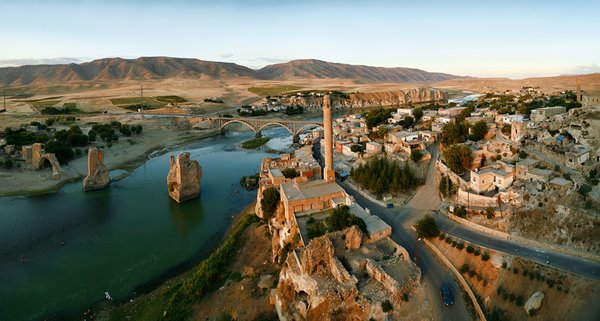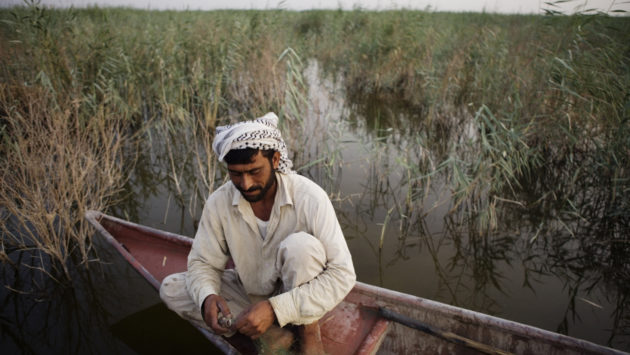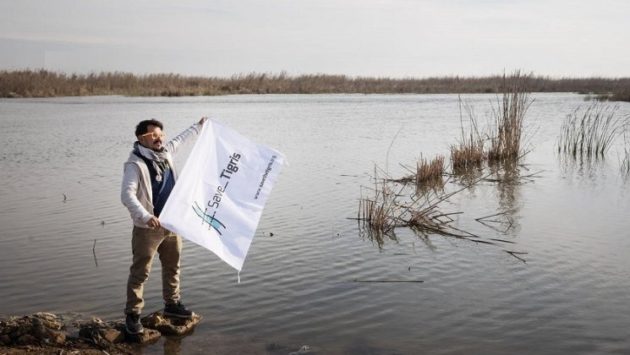Hasankeyf Selected by Europa Nostra for 7 Most Endangered Program
Initiative to Keep Hasankeyf Alive, 16 March 2016
The historic town of Hasankeyf, located on the Upper Tigris River in southeastern Turkey, has been selected as one of Europe’s “7 Most Endangered” heritage sites for 2016. The announcement, which noted that Hasankeyf is one of Europe’s most important archaeological sites, was made today in Venice by Europa Nostra, Europe’s leading heritage organization, and the European Investment Bank Institute.
The nomination was submitted by the Cultural Awareness Foundation and supported by Hasankeyf Matters and the Initiative to Keep Hasankeyf Alive as a step toward preserving the town and supporting an ongoing dialogue about heritage conservation and sustainability. Hasankeyf is under direct threat by the Ilısu Dam and Hydroelectric Power Plant Project. If implemented as planned, this project will flood the town and destroy most of its archaeological treasures.
Hasankeyf in historical context
With a history extending 12,000 years, Hasankeyf holds some of the earliest evidence of organized settlement discovered anywhere. Known as “Kifas” in Aramaic, the city was a center for Syriac Christians and became the seat of a Nestorian bishop in the 5th century CE. From the earliest years of the Islamic expansion, “Hisn Kayfa,” as it is called in Arabic, served as an administrative capital for the region.
At the height of its prosperity in the 12th-15th centuries, Hasankeyf was famous for its architectural and technological innovations and displays even today extensive examples of Seljuk-era urban infrastructure, including roads, water distribution networks and manufacturing facilities. Its skyline, dominated by the pylons of a 12th-century bridge (the largest of its day) and the minarets of two 15th-century mosques, serve as a reminder that Hasankeyf is also the product of numerous cultures and civilizations, including the Turkmen Artukids and the Kurdish Ayyubids. Several monuments reflect both Sunni and Shi’i influences, and in addition to the town’s numerous mosques and churches, Ottoman population records show that Hasankeyf continued to be inhabited by both Muslims and Christians for centuries.
Hasankeyf and the surrounding Tigris Valley are of extraordinary value to all humanity. The area was declared a First Degree Archaeological Site by Turkey’s Supreme Board of Monuments in 1978 and has been under the protection of the Culture Ministry’s General Directorate of Antiquities and Museums since 1981. However, Turkey has not nominated the site for World Heritage status, despite the fact that it likely fulfills 9 of 10 UNESCO criteria, according to a Stanford University/Doğa Derneği study authored by Zeynep Ahunbay and Özge Balkız.
Exploring alternative approaches to heritage conservation and sustainability
Within the framework of the 7 Most Endangered program, a team of heritage and financial experts from Europa Nostra and the European Investment Bank Institute will assess the site and help formulate a feasible action plan for conserving Hasankeyf and its invaluable universal heritage. This study will be conducted in close cooperation with public and private stakeholders in Turkey and will take into consideration the investments that have already been made in the area’s development.
The Government of Turkey has its own vision for salvaging select monuments and developing the site for tourism. However, no detailed salvage plan has been disclosed to the public, and there has been little consultation with representatives of the local and regional population to address their aspirations for economic advancement and safeguarding cultural heritage. The lack of a viable scheme for protecting Hasankeyf’s monuments contributed to the decision taken by Germany, Austria and Switzerland in 2009 to withdraw export credit support for the Ilısu Project.
It is hoped that a locally grounded management strategy can be developed to balance heritage conservation and economic growth within the broad urban ecosystem of Hasankeyf and surrounding villages. Already the first steps to spur sustainable growth are visible in the ecological villages project launched by the Hasankeyf District Governor in the nearby village of Üç Yol with the support of the Tigris Development Agency (DiKA). Given its historical significance and appealing setting, Hasankeyf and its hinterlands, which in recent years have attracted hundreds of thousands of visitors, could accommodate 2 million tourists and generate tourism-related revenues of €500 million annually.
Europa Nostra’s 7 Most Endangered program presents an opportunity for the Turkish Government to share best practices in heritage conservation and sustainable economic growth, for example by publishing a detailed action plan to realize its vision for Hasankeyf. Ideally, in order to allow time for consensus-building among all stakeholders, construction of the Ilısu Dam and related projects should be suspended to allow for a fully participative discussion at all levels of society. Hasankeyf could become a model for implementing the United Nations’ 2030 Sustainable Development Goals, which call for cities to be “inclusive, safe, resilient and sustainable” by emphasizing the need to “protect and safeguard the world’s natural and cultural heritage.”
Find this statement on the website of Initiative to Keep Hasankeyf Alive:
http://www.hasankeyfgirisimi.net/?p=356#more-356
Announcement of Europe Nostra
http://www.europanostra.org/news/704/





